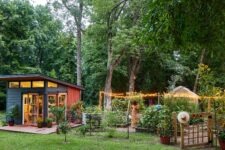
This Dreamy DIY Veggie Garden Overflows with Ideas
Ashlie and Tyler Thomas’s North Carolina backyard is the stuff of DIY vegetable garden dreams. Nearly everything in it—including the raised beds, trellises, and greenhouse—was built by Tyler. Ashlie starts many of the leafy greens, roots and tubers, and a whole host of fruits from seed. But when the couple started their garden a few years ago, they had almost no growing experience. Here’s how they went about building and their first veggie garden from the ground up.
Hector Sanchez
A health coach and grad student in nutritional science by day, Ashlie Thomas has also become a role model for new gardeners. “Access to nutritious food is so challenging for so many people,” she says. “I thought, What if we could teach other people to do what we’re doing using the space they have?” To that end, she’s spent the last few years documenting her garden on Instagram (@the.mocha.gardener). She also recently published her first book, How to Become a Gardener: Find Empowerment in Creating Your Own Food Security (Cool Springs Press).
Hector Sanchez
DIY Vegetable Garden Beds
When Ashlie and Tyler started out, they had nothing but empty land. Here’s what they recommend as you start planning and building your first vegetable garden beds.
Choose a location: Before doing anything, the couple says it’s imperative to watch the sunlight. They tracked it over months to figure out where to situate their raised garden beds. That way, they could ensure their beds would get eight hours of sun a day (the recommended amount of sunlight for most vegetables and fruits).
Construct beds: The couple opted for raised beds over in-ground planting because they would allow them to control for the many kinds of soil and to dodge the root systems of the mature oaks on the property. Tyler constructed 11 raised beds out of recycled 2x4s and fencing picket panels to save money. While Tyler has a background in construction, building your own beds is a fairly simple carpentry project.
Build supports: You can save money—and customize your garden—by building your own trellises, like Tyler did, out of recycled wood. “Sometimes we opt for building over purchasing because we are able to customize things to our own aesthetic,” says Ashlie. The trellises allow cucumbers and other vining fruits and veggies, such as squash, small melons, and snap peas, to climb; the added air circulation discourages disease, including powdery mildew.
Hector Sanchez
Hector Sanchez
Hector Sanchez
Vegetables, Fruits, and Flowers
Once the beds were in place, the couple could focus on growing. With little previous gardening experience, they dove into learning and experimenting with different crops.
Tap experts: For your first growing season, Ashlie and Tyler recommend studying up. They got advice from the gardeners in their families, checked with their local agricultural extension for specific crop recommendations, and read several books on edible gardening.
Grow what you’ll eat: Start with familiar crops you know you’ll love, says Ashlie, as well as easy ones that will help build gardening confidence. Over the years, her and Tyler’s garden has grown to include eggplants, melons, turnips, potatoes, apples, peaches, plums, elderberries, and blueberries. Their palettes have evolved with their garden, too: “I didn’t used to like tomatoes, but I only had experience with commercial ones,” says Ashlie. Home-grown sweet ‘Sungold’ tomatoes and deeply colored ‘Cherokee Purple’ tomatoes made her a convert.
Encourage pollinators: Planting pollinator-friendly flowers, such as salvias, marigolds, and zinnias, draws bees and butterflies to the beds, where they pollinate the veggies. They also lend color and beauty to the beds.
Track your progress: Ashlie created a database to track where she plants seeds year to year, record which plants do best in which locations, and plan crop rotation to discourage disease. “This method keeps me from getting overwhelmed when it’s time to plan where to plant,” she says.
“You’re not just cultivating a space—you’re cultivating yourself.”
-Ashlie Thomas
Hector Sanchez
DIY Shed and Greenhouse
Beyond the raised beds, the couple increased their growing opportunities with a shed and greenhouse, as well as a space-saving planter.
Create a dual-purpose space: If you want to make your DIY vegetable garden super-functional, Ashlie and Tyler recommend a garden shed. Tyler built theirs on a budget: The shiplap siding came from Facebook Marketplace, the flooring was on sale at a hardware store, and the lighting and solar panel equipment came from Amazon. The couple splurged on full insulation, making the shed comfortable year-round, and outfitted it with an affordable IKEA sink for when Ashlie cans pickles and distills essential oils.
Go vertical: A small deck gives the shed a sense of permanence. It also holds a Green Stalk Garden vertical planter, which lets the couple grow a ton of herbs— including thyme, oregano, sweet and Thai basil, parsley, and rosemary—in a small footprint.
Garden year-round: The couple’s most recent addition is a small store-bought greenhouse where Ashlie keeps tropical fruit plants and starts seeds in the cool months. She’s learned a few lessons about greenhouses over the years: make sure there’s adequate ventilation, add a heater during the winter, and reinforce the framing so the structure itself can handle any storms. They thoroughly clean the space twice a year to keep mildew on the panels at bay.
Hector Sanchez
“Check places like Facebook Marketplace, local lumber yards, or even the discount sections of big box stores,” recommends Ashlie. “Certain times of the year, building materials will be marked down due to excess or discontinued inventory.”
Between the greenhouse, the shed, and the garden, the couple is able to keep gardening, learning, and sharing their experience year round. “Documenting this on Instagram allows me to keep track of the journey,” she says. “It’s a matter of being able to reflect on the process.”



